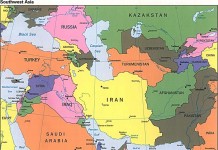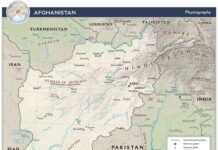Context
 The circumstances that doomed the TTP maestro in a drone strike on November 1st, and Haqqani Network’s top leader Nasiruddin Haqqani in an ambush on November 11th have become hotly debated topics. The events are particularly intriguing since they have followed each other in quick succession, and soon after Nawaz Sharif’s visit to the US in late October. After his US visit, Nawaz Sharif, Karzai, and David Cameron met for a trilateral session in London. In early October, another TTP leader Latifullah Mehsud was reportedly snatched by the Americans right from the hands of Afghan intelligence. This obviously irritated the Afghans greatly, presently in the midst of finalizing the bilateral security agreement with the US.
The circumstances that doomed the TTP maestro in a drone strike on November 1st, and Haqqani Network’s top leader Nasiruddin Haqqani in an ambush on November 11th have become hotly debated topics. The events are particularly intriguing since they have followed each other in quick succession, and soon after Nawaz Sharif’s visit to the US in late October. After his US visit, Nawaz Sharif, Karzai, and David Cameron met for a trilateral session in London. In early October, another TTP leader Latifullah Mehsud was reportedly snatched by the Americans right from the hands of Afghan intelligence. This obviously irritated the Afghans greatly, presently in the midst of finalizing the bilateral security agreement with the US.
Various angles surrounding these happenings are being debated in the print and electronic media, and intelligence agencies of various nations are being blamed to build one case or the other. The interrelationship of Afghan Taliban, Haqqani Network, and TTP is also being evaluated, and how that may have led to their deaths. None or very few debates, however, have attempted to examine the events from the broader perspective of post 2014 Afghanistan. Moreover, these media deliberations fail to take in to account the unusual quiet maintained by the Pakistan government and the US. The silence is part of the confusion and also perhaps the reality.
The Changing Dynamics
In interpreting the emerging situation, it is tempting to fall for the existing narrative; Pakistan protects the Good Taliban and acts against the Bad Taliban. One of the arguments suggests India, Afghanistan and US may have been supporting the Bad Taliban (TTP) against Pakistan. The arrest of Latifullah Mehsud and the death of Hakimullah Mehsud in a drone strike, both negate the hypothesis that US was supporting TTP. However, it does support the theory that Afghanistan, and possibly India, have developed, or are in the process of developing leverage over Pakistan using Afghan territory.
On the other hand, the silence over the killing of Nasiruddin Haqqani indicates Pakistan may have finally agreed to a quid pro quo with the Americans and the Afghans, and possibly India as well. Recent statements coming out of India regarding the sincerity of Nawaz Sharif, and the travel of Mullah Zaeef to India, may be connected to this.
Pakistan’s Response and Direction of Ties with US
Pakistan’s official statements meant for the public, are full of contradictions. While the country has been in an uproar since the drone strike on November 1, the Ministry of Defense Statistics quoted by the Interior Minister provides a very low count for civilian casualties resulting from the drone attacks. This all but supports the efficacy of the strikes, against which the Prime Minister was to present a case to Obama. Furthermore, as opposed to reviewing all aspects of Pakistan’s ties with the US, as claimed by the Nisar Ali Khan in the aftermath of Hakimullah’s death, a roller coaster of federal ministers and officials are visiting Washington. On the agenda are talks related to US-Pakistan strategic relationship, including economics, energy and extremism.
Even the senior PTI leader Asad Umar, whose party is threatening to block the NATO supply line on the 23rd, called for American companies to invest in energy exploration in KPK on his visit to the US. Asad Umar’s itinerary mimics that of Shahid Khaqan Abbasi and Khawaja Asif, who are also on a trip of US as part of the strategic talks on energy. What one senses is not the customary tension between the two nations but a new sense of direction and vigor.
Why the Change of Heart?
The question is why would Pakistan’s government want to convey a different version of the reality to its public. Moreover, why would it agree to go after all brands of Taliban at this juncture when US and NATO troops are already slated to withdraw in late 2014?
There are a number of reasons for this, the first one being the game changing US-Iran thaw. Now that western tensions with Iran are easing, it could very well take away Pakistan’s supply line leverage. Second, contrary to what many assume, due to their own problems with extremism, Russia and China are not against limited US presence in Afghanistan. While China remains an all weather friend, it just completed a joint military exercise with India, which was geared towards fighting extremism. Moreover, how the Security Council has dealt with the Syrian chemical weapons provides a risky precedence as it relates to Pakistan, especially if law and order situation continues to deteriorate.
While PoliTact had previously assessed that Pakistan is not fully betting on Afghanistan stabilizing anytime soon and is instead focusing more on the Kashgar-Gawadar economic trade zone, the emerging regional and global security landscape may have pushed it to rethink. Without stable political and economic condition, none of the hyped economic projects of the Nawaz government could materialize. Under the present circumstances, the best way to achieve a conducive economic environment requires pressurizing Afghan Taliban to reconcile and weaken TTP. This turnabout, however, may come with a hefty reply and therefore must be best achieved quietly: as the events and the government response seem to portray.
The risk being Pakistan’s public is not in the loop as it braces for the possibility of a serious Taliban backlash. Mitigating what the future may entail is perhaps the reason the leadership of moderate religious parties like JI and JUI-F have responded the way they have to what constitutes a martyr. It could be taken as a warning to the government that if the circumstances changed, these parties cannot be expected to maintain the traditional position on the war, as it would mean losing public credibility. In this trajectory, ultimately the military may have to act as the Egyptian army did in support of secular forces, but it’s the conservative and nationalist elements that are resurgent in Pakistan.



